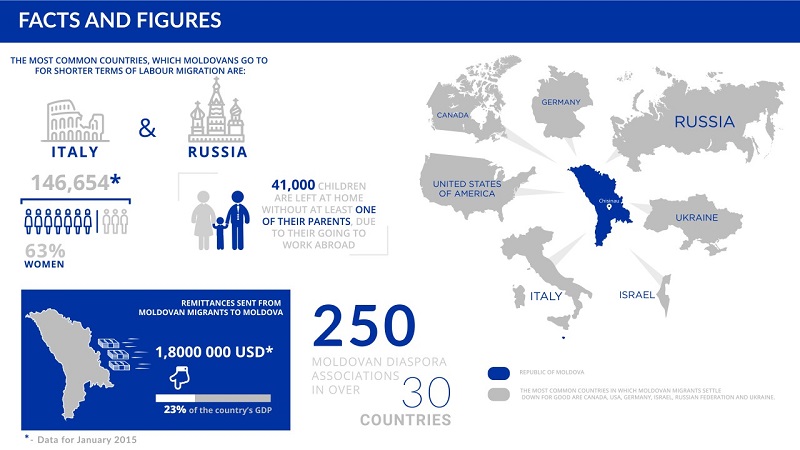-
Who We Are
WHO WE AREThe International Organization for Migration (IOM) is part of the United Nations System as the leading inter-governmental organization promoting since 1951 humane and orderly migration for the benefit of all, with 175 member states and a presence in over 100 countries. IOM has had a presence in Moldova since 2001.
About
About
IOM Global
IOM Global
-
Our Work
Our WorkAs the leading inter-governmental organization promoting since 1951 humane and orderly migration, IOM plays a key role to support the achievement of the 2030 Agenda through different areas of intervention that connect both humanitarian assistance and sustainable development. In Moldova, IOM supports migrants through a variety of resettlement, support and protection activities.
Cross-cutting (Global)
Cross-cutting (Global)
- Data and Resources
- Take Action
- 2030 Agenda
Since proclaiming its independence on 27 August 1991, the Republic of Moldova has gone through several migratory periods distinguishable by dynamics such as push and pull factors, level of prevalence of migration, direction and composition of migratory flows, duration and legal status of migrants’ stay in host countries.
At this stage, Moldova is primarily a country of origin of migration, and to a much lesser extent a country of destination or transit for migrants. Regarding the latter, data shows that only an insignificant number of irregular migrants to the EU use Moldova as transit country. The migration situation is predominantly characterized by emigration of Moldovan citizens, while immigration of non-citizens or foreign-born persons can be described as insignificant from a statistical point of view.
Hence, Moldova is a source country of migrants. Around the year 2000, outward migration progressively increased to significant proportions compared to the population.
Various official and independent sources provide data on Moldova’s migration trends.
According to the Border Police data, on 31 December 2015, the amount of Moldovans currently residing abroad was approximately 753,800, roughly 20,000 of whom were absent for a period of 12 months and beyond. According to the NEXUS study carried out in 2013 “Survey of households: Country’s Migration Profile (2013)”, 411,566 persons were abroad, out of which 30% come from the urban areas and 70% from the rural areas.

Temporary labour migration remains the most widespread form of emigration from Moldova. Therefore, the data of the Labor Force Survey, carried out annually by the National Bureau for Statistics, reveal an increase from 138,000 in 2000 to 341,900 in 2014 of migrant workers, including the persons aged 15 years old and over, who have left abroad to work or to look for a job at the moment when the survey was conducted.
Since the late 1990s, migration from Moldova has been directed towards two regions: The Commonwealth of Independent States (CIS) countries, predominantly Russia (more than 55% of Moldovan migrants in 2014), as well as Western Europe, particularly Italy (more than 15% of Moldovan migrants in 2014).
The main push factor for Moldovan migrants is economic: poverty, lack of adequate employment opportunities and low salaries, while higher living standards abroad act as a pull factor.
The Government through its national migration policy pays now more attention to migration (both emigration and immigration), especially because it has a considerable development impact on all sectors of the society and because the country set a number of EU approximation objectives.
Managing Moldova's migration flows, much of which are not regular, is a major challenge for the Moldovan Government and its partners in the international community, including IOM. The country has experienced problems with trafficking in human beings.
It is impossible to give an accurate total number as many cases go unreported to law enforcements and/or social welfare institutions. The full scale of trafficking from/in Moldova remains unknown because many victims are not identified in the destination countries or in Moldova. This is due to changing trends in trafficking, fear of stigmatization, low level of self-identification, limited knowledge of human rights and trafficking issues, as well as the inability or unwillingness of some victims to report their trafficking experiences to the authorities.
However, one sign of the extent of the trafficking phenomenon in Moldova is the total number of those assisted as victims of trafficking by IOM Chisinau. From 2000 to 2013, this number is 3,194 persons.
The above-mentioned trends are a number of different challenges to a modern and efficient management of migration.
Increasing awareness of migration as a phenomenon liable to produce not only negative social costs, but also positive development outcomes for the country and the commitment to a proactive management of migration challenges and opportunities, led to intensive legislative and policymaking activities of the Moldovan Government.
In line with the international standards and given the European integration aspirations of the country, IOM supported the adoption and implementation of an array of practices, conceptual documents and laws that determine migration policy in the key areas of migration management.
The Moldovan Government has recognized the need for a coordinated and integrated approach to manage migration through for instance the National Development Strategy 2012–2020, which includes a focus on harnessing remittances and youth emigration, as well as the National Strategy on Migration and Asylum 2011–2020.
The latter aims at developing inter-sectorial policies in the areas of legal migration, asylum system, irregular migration, integrated border management, visa policy, observance of human rights and freedoms, etc., and acknowledges the need to correlate migration management with the economic, political, and social policies.
Yet the prevalence of migration and its ramified impact on Moldova indicate the need to assess the mutual linkages between migration and each development sector, and further suggest the need to take into account the impact of migration when developing public policies.